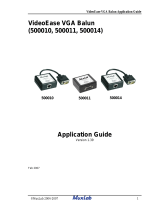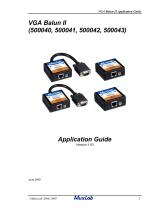9
CHAPTER 3: Installation
7. The four-position DIP switch marked MONITOR TYPE on the front
panel of the VGA Video Splitter tells the VGA adapter in your computer
what type of monitors you have connected when the computer boots up.
For a standard application in which your remote monitor(s) are pretty
much interchangeable with your primary monitor (the one on
MONITOR 1), move all four switch positions to the “UP” setting; this
will cause the Splitter to pass the “ID bits” from the primary monitor
through to the VGA adapter. Moving all the positions to UP will not
work for applications in which:
• there is no monitor on MONITOR 1;
• the primary monitor is connected to MONITOR 1 with a VGA
extension cable that doesn’t carry the ID-bit leads;
• the primary monitor uses higher-grade video than one or more of the
remote monitors (for example, color VGA vs. monochrome VGA or
high-resolution XGA-2 vs. low-resolution VGA).
In these situations, set the MONITOR TYPE switch this way:
DIP Switch Positions Monitor Type
1234
DOWN UP DOWN UP Color VGA and XGA
DOWN DOWN UP UP Monochrome VGA
UP UP DOWN UP 8514/A
NOTE
If your monitors don’t belong to any of these three types, you must set
all four MONITOR TYPE switch positions UP and connect a
representative monitor to MONITOR 1 with cable that carries the
monitor’s ID-bit leads. If you don’t have such a cable, call your supplier
for a quote on a cable that carries all ID-bit leads.
8. Turn on the computer and the monitors. The monitors should now
display the computer’s output.
This completes the VGA Video Splitter installation. Once installed, the
Splitter shouldn’t require any adjustments; you can keep it out of sight.
It should now be ready for continuous operation.















